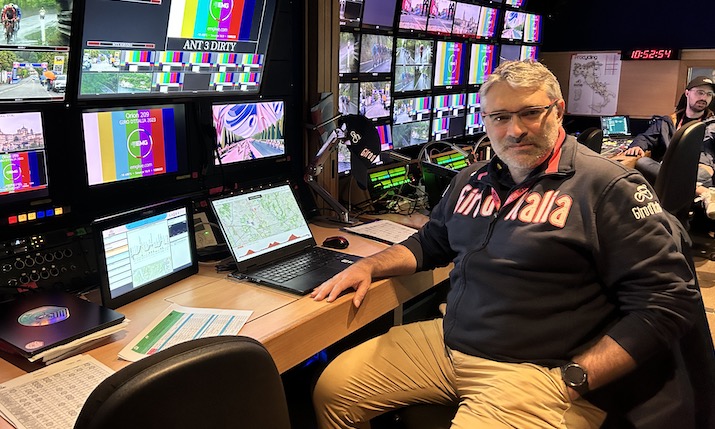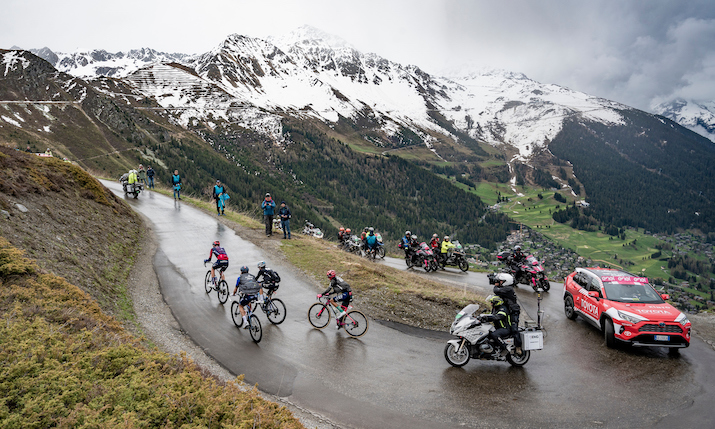Live from Giro d’Italia: RCS Sport’s Andrea Basso on the latest innovations enhancing a complex production

Andrea Basso, head of TV productions and media rights, RCS Sport
Organised by RCS Sport, the Giro d’Italia sees the world’s best cyclists race through the landscapes, territories and regional communities of Italy from 6-28 May. For the second consecutive year, EMG is capturing all the action as host broadcaster.
SVG Europe speaks to Andrea Basso, head of TV productions and media rights at RCS Sport, to find out more about the challenging production of the event.
What are your main tasks and how do you deal with such a long and complex event?
At RCS, we plan all the production activities of the events we organise. Obviously we start with the selection of suppliers and their co-ordination. We have a three-year agreement with EMG for the Giro d’Italia, specifically with its divisions in Italy, Belgium and France, with each having their own area of specialisation – direction, radio frequency and connections. The experience of my colleague Marco Certaldi is fundamental in this phase. Before joining RCS he worked for years as engineer in chief on large international productions, from superbikes to the Champions League.
The focus then moves on to the editorial content, and in particular to the analysis of the territory and the identification of the points of interest to be covered during the live shows.
At RCS Sport we also manage all the activity linked to media rights, including the relationship with international broadcasters and takers, particularly with regard to their on-site presence.
More on Giro d’Italia:
- Live from Giro d’Italia: EMG’s Gunther Herregodts and Bruno Coudyzer – ‘For us, cycling is religion!’
- Live from Giro d’Italia: Inside the travelling TV compound that needs to be ready for anything
- Boost Graphics partners with RCS for timing, live graphics and data processing of the Giro d’Italia 2023
- Grand Tour season spins onto screens as Warner Bros. Discovery presents its global Giro D’italia coverage
When does such a complex operation start and how does it develop?
For this year’s Giro, we started carrying out site inspections in September 2022, to personally verify the various geographical locations.
We need to do this to understand what the difficulties will be and the peculiarities of each stage as no two arrivals are ever identical. This is what makes the Giro so varied and is the real challenge of our work. In practice, there is always something to adapt.

Race leaders coming up the Croix de Coeur during the 2023 Giro d’Italia 2023 ©kramon
The production has been entrusted entirely to EMG for three years. How is it going and can we expect anything new in terms of ideas and innovation?
This is the second of a three-year contract with EMG and it is the second year of self-production, after the long period in which all content was produced by and with RAI.
We are happy with this choice, which represents a large investment on our part, and which must be considered in the long term. In fact on some issues we haven’t expected a complete revolution from night to day, but slow and constant improvements in co-operation with EMG.
On other strategic points, however, we have seen radical change. For example, in the mobile signals section there was a truly immediate and evident improvement: such excellent management of the RF signals made it possible to derive a very high image quality.
Going back to the long-term perspective, we are working to get up to speed; in fact last year was almost a running in, but then we started concretely with the idea of constantly improving the product.
It is no coincidence that we have included new features both from an editorial and qualitative point of view, starting with the graphics which, created by EMG subsidiary Boost Graphics, have been revolutionised and made much more complete, participatory and spectacular.
For us, technology is the driving force and it is essential to follow and promote the path of ideas and innovation on which RCS is working.
Last year, we had to speed up because we started a little late, while for this second edition together we were able to do everything more calmly and better architect the dynamics.
In addition to the enhanced visual quality and the renewed graphics, is there anything else new that the viewer can enjoy from home?
Yes. This year we managed to start an experiment that involves inserting QR codes into the television stream which, thanks to Boost Graphics, we are able to insert into the live feed to try to fill the gap that historically exists between the one-way broadcast world and the digital world that allows for interactivity.
So we tried for the first time to direct and transport the viewer from the typical TV screen to digital platforms and vice versa. This allows us to better share and integrate the content produced by both the broadcast team and that created by the digital team.
This too contributes to creating that concept of always having the best possible images and colliding two universes that often do not fully communicate.

